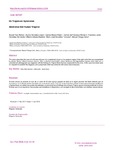Síndrome del hueso trígono

View/
Use this link to cite
http://hdl.handle.net/2183/21938Collections
Metadata
Show full item recordTitle
Síndrome del hueso trígonoAlternative Title(s)
Os trigonum syndromeAuthor(s)
Date
2018Citation
European Journal of Podiatry, 2018, 4 (1): 31-34 ISSN: 2445-1835
Abstract
[Abstract] This article describes the case of a 40-year-old man who complained of pain in the posterior region of the right ankle that was exacerbated by plantar flexion without previous trauma. After a physical examination where tendinous and ligamentous injuries were ruled out, a conventional radiology test was requested with the finding of a Trigone Bone that was responsible for the clinic. In this case more tests were not required to establish the diagnosis and symptomatic relief was achieved with conservative measures [Resumen] En este artículo se presenta el caso de un varón de 40 años que se quejaba de dolor en la región posterior del tobillo derecho que se exacerbaba con la flexión plantar del tobillo sin traumatismo previo. Tras una exploración física donde se descartaron lesiones tendinosas y ligamentosas, se solicitó una prueba de radiología convencional con el hallazgo de un Hueso Trígono que era el responsable de la clínica. En este caso no se requirieron más pruebas para establecer el diagnóstico y se consiguió el alivio sintomático con medidas conservadoras
Keywords
Astrágalo
Enfermedades raras
Articulación del tobillo
Huesos del Tarso
Talus
Rare diseases
Ankle joint
Tarsal Bones
Enfermedades raras
Articulación del tobillo
Huesos del Tarso
Talus
Rare diseases
Ankle joint
Tarsal Bones
Editor version
ISSN
2445-1835





